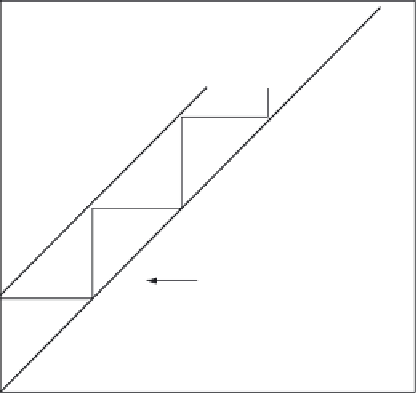Geoscience Reference
In-Depth Information
(X
1
, Y
1
)
G
Operating line
F
E
Y
D
C
Equilibrium line
(X
2
, Y
2
)
B
A
[Note: Lines AB-BC are one theoretical plate.
Need a total of 2.3 plates]
X
FIGURE 16.11
Graphical determination of the number of theoretical plates. (From USEPA,
APTI Course
415: Control of Gaseous Emissions
, EPA 450/2-81-005, U.S. Environmental Protection Agency Air Pollution
Training Institute, Washington, DC, 1981, p. 4-35.)
Equation 16.14 is used to predict the number of theoretical plates (
N
p
) required to achieve a given
removal efficiency. The operating conditions for a theoretical plate assume that the gas and liquid
stream leaving the plate are in equilibrium with each other. This ideal condition is never achieved in
practice. A larger number of actual trays are required to compensate for this decreased tray efficiency.
Three types of efficiencies are used to describe absorption efficiency for a plate tower: (1) an
overall efficiency, which is concerned with the entire column; (2) Murphree efficiency, which is
applicable with a single plate; and (3) local efficiency, which pertains to a specific location on a
plate. The simplest of the tray efficiency concepts, the overall efficiency, is the ratio of the number
of theoretical plates to the number of actual plates. Because overall tray efficiency is an oversim-
plification of the process, reliable values are difficult to obtain. For a rough estimate, overall tray
efficiencies for absorbers operating with low-viscosity liquid normally fall in a range from 65 to
80%. Example 16.6 shows a procedure to calculate the number of theoretical plates.
■
EXAMPLE 16.6
Problem:
Calculate the number of theoretical plates required for the scrubber in Example 16.5,
using the same conditions as in Example 16.4. Estimate the total height of the tower if the trays are
spaced at 0.53-m intervals and assume an overall tray efficiency of 70%.
Solution:
From Example 16.5 and the previous examples the following data are obtained:
m
= 42.7
G
m
= 3.5 kg-mol/min
L
m
= 204 kg-mol/min
X
2
= 0 (no recycle liquid)
Y
1
= 0.03
Y
2
= 0.003
The number of theoretical plates from Equation 16.14 is





Search WWH ::

Custom Search